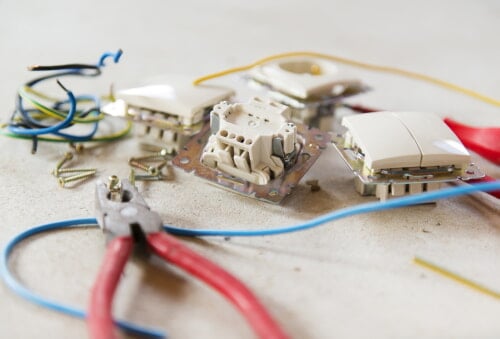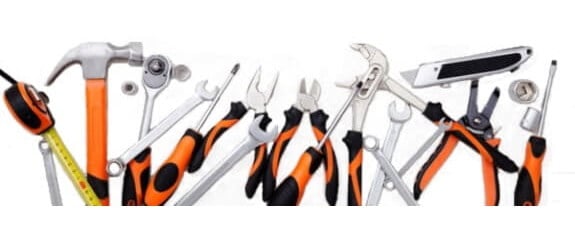Which is Better for Hand Tools – Chromium-Molybdenum or Chromium-Vanadium Steel?
Hand Tools

Hand tools are made of two types of steel alloys: Chromium-molybdenum or chromium-vanadium. Once the steel is manufactured, the two forms are nearly identical in chemical composition. Because steel is a soft metal, manufacturers add alloys to harden it and help resist corrosion. Even when these metals are added, the steel is relatively soft, so manufacturers heat treat it to further harden it. While high-carbon steel is also a strong material, it doesn’t have some of the properties that adding alloy gives it. Abolox carries hand tools made of both types of alloy steel, including socket sets, wrenches, screwdrivers and more.
Chromium-molybdenum is sometimes referred to as chrome-moly or CR-M, while chromium-vanadium is often referred to as CR-V or CR-Va. Both are heat-treated to extend the hardening properties of the alloys. By the time the process is completed, both produce a high-quality tool.
What Metals Are Used in the Steel for Hand Tools?
Steel is about 90 percent iron that has small amounts of carbon – usually 2 percent or less. If a manufacturer doesn’t heat treat it and add alloying elements – molybdenum or vanadium – the steel is too soft for hand tools.
However, by adding alloying elements and heat-treating the steel, it becomes brittle – but they are strong. The best steel for hand tools has a good combination of hardness, toughness, strength and ductility.
- Hardness is the degree of resistance to scratching and wearing out.
- Strength is the degree to which the material can be stressed before it becomes permanently deformed.
- Ductility is the degree of flexibility – how far you can push it before it becomes permanently deformed or breaks.
- Toughness is the degree of a combination of strength and ductility – the ability to absorb energy without breaking.
How Heat Treating Makes Hand Tools Stronger and Corrosion Resistant
When you heat treat steel, you raise the temperature. The immediate cooling after heating changes the structure of the metal. If you were to look at non-heat-treated steel under a microscope, you would see many small grains. These are groups of atoms that are arranged in crystals.
The heating process changes the size of the grains. It also changes the arrangement of the atoms. Larger grains sliding past each other make the material softer. Smaller grains make it harder. The various geometric arrangements are austenite, ferrite and martensite. Depending on how the steel is heated and cooled, it has different size grains and different arrangements, both of which can make the steel more useful for hand tools.
Adding Alloys
If the steel is just iron and carbon, it is called carbon steel. The amount of carbon determines the hardness of the metal. Low-carbon steel is weak and will not respond well to the heat treating process. If the steel has a lot of carbon, it is still weak but does respond better to the heat treating process.
This is where alloys come in. Various elements have different benefits.
- Boron makes it easier to harden steel. Metals using both alloys could have boron added to the mix.
- Chromium makes the steel harder and stronger. It also makes it easier to harden and resists corrosion. When you add a lot of chromium, you get stainless steel.
- Manganese helps resist corrosion from oxidation.
- Molybdenum, like boron, makes the steel easier to harden. It also makes it stronger and increases toughness.
- Nickel also makes the steel harder and resists corrosion.
- Vanadium reduces the grain size in the manufacturing process and increases high strength and toughness of the product.
Elements in Steel
While carbon is effective in hardening steel, chromium-molybdenum, often called chrome-moly, and chromium-vanadium are more effective. They also add a high degree of corrosion resistance. Chromium-molybdenum steel has a 0.4 percent to 0.5 percent of carbon, about 1 percent of chromium, and 0.15 percent to 0.20 percent of molybdenum. It also has small amounts of other elements.
Chromium-vanadium has about 0.4 percent to 0.5 percent carbon, about 1 percent of chromium, 0.15 percent to 0.20 percent vanadium, and small amount of other alloy elements.
The Society of Automotive Engineers (SAE) gives steel certain numbers. Chrome-moly has numbers that start with 4x. The second number is the amount of carbon in chromium-molybdenum. Thus, 4140 has 0.40 percent carbon, as indicated by the second two numbers.
Chromium-vanadium types start with a ‘6.’ Thus, 6150 steel has 0.50 percent carbon.
Both types of steel are hardened to similar levels, which means that once processed, they have about the same degrees of hardness and durability. Both are frequently used to manufacture socket tools, ratchets, wrenches, and other tools.
Additionally, both types of steel have additional alloys added to them, but they are in small amounts.
Which Alloy is Better for Hand Tools?
If you’re looking for quality hand tools, you might have noticed that some are made from chromium-vanadium and some from chromium-molybdenum. Because you are not a scientist, you would have no idea if one is better than the other, better for certain applications, or why one might be better than the other.
Both are hardened with alloys to create a quality tool. Both are rust-resistant. And both types can be used for most hand tools. However, some wholesalers boost the price on one or the other as a marketing gimmick.
Hand Tools Abolox Carries

Abolox carries several hand tools. When you need to replace a tool or need to purchase more tools for your workshop, you’ll find top-quality tools at more than reasonable prices.
Hand tools we carry include:
- Driver tools, including attachment tools, handles, hex keys, nut drivers, ratchets and screwdrivers.
- Hammers, punches, chisels and pry bars.
- Insulated tools.
- Metalworking tools, including annular cutters, countersink bits, cutting bars, die tools, drill bits, end mills, reamer tapers and tap bits.
- Pliers and clamps, including C-clamps, cutters and snips.
- Socket tools, including common sockets, hex bit sockets, replacement bits and socket accessories.
- Torque tools, including torque wrenches, torque calibration systems, torque accessories, torque multipliers, interchangeable head torque wrenches, transducers and torque testers.
- Tool sets, including clip rails, hex key sets, master sets, nut driver sets, pliers sets, screwdriver sets, socket sets, wrench sets, file sets, Torx bit sets, safety wiring kits, adapter sets, ratchet sets, adjustable wrench sets, chisel sets, hole saw sets, insulated tool sets and more.
- Wrenches, including adjustable wrenches, box wrenches, combination wrenches, crowfoot wrenches, flare nut wrenches, open end wrenches, pipe wrenches, ratcheting wrenches, service wrenches, striking wrenches and structural wrenches.
- Measurement tools, including feeler gauges.
- Repair kits and replacement bits.
- Shaping and cutting tools, including files, replacement blades, saws and scrapers.
What Does Abolox Carry?
Abolox carries several brands, so we have a mix of chromium-molybdenum and chromium-vanadium tools. Some tools are available in one or the other because that is what manufacturers use based on their supply chains. For example, a brand might use 4140 chromium-molybdenum while another brand might use 6150 chromium-vanadium.

